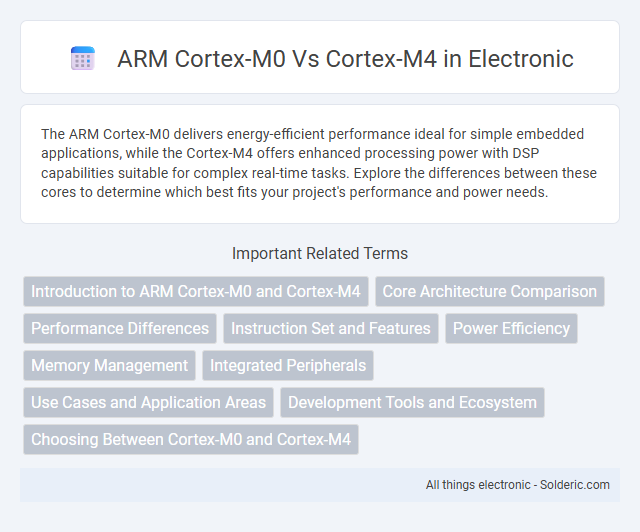The ARM Cortex-M0 delivers energy-efficient performance ideal for simple embedded applications, while the Cortex-M4 offers enhanced processing power with DSP capabilities suitable for complex real-time tasks. Explore the differences between these cores to determine which best fits your project's performance and power needs.
Comparison Table
| Feature | ARM Cortex-M0 | ARM Cortex-M4 |
|---|---|---|
| Processor Core | ARMv6-M | ARMv7E-M |
| Clock Speed | Up to 50 MHz | Up to 100+ MHz |
| Performance | 0.9 DMIPS/MHz | 1.25 DMIPS/MHz |
| Instruction Set | Thumb-1 | Thumb-2 with DSP |
| Hardware Floating Point | No | Optional (FPU) |
| Digital Signal Processing (DSP) | No | Yes |
| Interrupts | 32 | Up to 240 |
| Power Consumption | Very Low | Low to Moderate |
| Applications | Basic embedded, low power devices | Advanced control, DSP, audio processing |
| Typical Usage | Simple MCUs, sensors | Motor control, audio codecs, medical devices |
Introduction to ARM Cortex-M0 and Cortex-M4
ARM Cortex-M0 delivers ultra-low power consumption and minimal silicon area, ideal for simple embedded applications and IoT devices requiring energy efficiency. Cortex-M4 combines high-performance DSP capabilities with a floating-point unit, targeting complex real-time applications such as motor control and digital signal processing. Your choice depends on the processing power and feature set needed for efficient embedded system design.
Core Architecture Comparison
The ARM Cortex-M0 features a 32-bit ARMv6-M architecture optimized for ultra-low power and cost-sensitive applications, offering a modest pipeline and limited DSP capabilities. The Cortex-M4, based on the ARMv7E-M architecture, delivers enhanced performance with a 3-stage pipeline, integrated DSP instructions, and optional floating-point unit, making it suitable for more complex embedded systems. Your choice between these cores depends on required processing power, real-time performance, and power consumption constraints.
Performance Differences
The ARM Cortex-M4 delivers significantly higher performance than the Cortex-M0, featuring a 32-bit processor with DSP instructions and an optional floating-point unit, enabling efficient handling of complex computations and digital signal processing tasks. The Cortex-M0 operates as a lower-power, entry-level 32-bit processor with a simpler pipeline and limited instruction set, resulting in lower clock speeds and reduced computational capabilities. Performance benchmarks typically show the Cortex-M4 achieving multiple times the processing throughput of the Cortex-M0, making it suitable for real-time applications requiring mathematical processing and control algorithms.
Instruction Set and Features
The ARM Cortex-M0 features a simplified 32-bit ARMv6-M instruction set optimized for low power and cost-sensitive applications, supporting basic instructions for efficient control tasks. In contrast, the Cortex-M4 utilizes the ARMv7E-M instruction set, including DSP and optional floating-point unit (FPU) instructions, enabling advanced signal processing and complex mathematical computations. Your choice depends on whether you need minimal processing with low power (Cortex-M0) or enhanced performance with DSP capabilities for embedded applications (Cortex-M4).
Power Efficiency
The ARM Cortex-M0 is designed for ultra-low power consumption, making it ideal for battery-operated devices that require extended operational life. In contrast, the Cortex-M4, while more powerful and capable of handling complex signal processing tasks, consumes more power due to its enhanced performance features. Your choice between these cores should balance the need for advanced processing capabilities with the importance of maintaining minimal energy usage.
Memory Management
ARM Cortex-M4 features advanced memory management capabilities, including a Memory Protection Unit (MPU) that enhances application reliability and security by controlling access permissions for different memory regions. In contrast, the Cortex-M0 lacks an MPU, providing only basic memory handling suitable for simpler applications. Your choice between the two will impact the complexity and safety of your embedded system's memory operations.
Integrated Peripherals
The ARM Cortex-M0 features a basic set of integrated peripherals suited for low-power, simple applications, including timers, UART, SPI, and I2C interfaces. In contrast, the Cortex-M4 integrates more advanced peripherals such as enhanced timers, multiple communication interfaces including CAN and USB, and DSP-specific hardware accelerators for signal processing tasks. These expanded peripherals in the Cortex-M4 support more complex embedded systems requiring higher performance and real-time processing capabilities.
Use Cases and Application Areas
ARM Cortex-M0 excels in low-power, cost-sensitive applications such as wearable devices, IoT sensors, and simple embedded systems requiring minimal processing power. Cortex-M4 targets more demanding tasks in industrial automation, motor control, and digital signal processing, benefiting from its DSP instructions and higher clock speeds. Your choice depends on whether energy efficiency and simplicity or performance and advanced computation dominate your project needs.
Development Tools and Ecosystem
The ARM Cortex-M0 benefits from a lightweight development ecosystem ideal for low-power, cost-sensitive applications, supported by basic toolchains like Keil MDK and GCC ARM embedded. In contrast, the Cortex-M4 offers a robust and mature development environment with advanced debugging, comprehensive middleware, and support for DSP libraries in tools such as IAR Embedded Workbench, ARM Keil, and SEGGER Embedded Studio. Rich ecosystem resources and community support make the Cortex-M4 preferable for complex signal processing and real-time control projects.
Choosing Between Cortex-M0 and Cortex-M4
Choosing between ARM Cortex-M0 and Cortex-M4 depends on your application's performance and power requirements. The Cortex-M0 offers ultra-low power consumption and cost-effectiveness for simple, low-speed embedded tasks, while the Cortex-M4 incorporates a DSP extension and floating-point unit for higher processing power and complex signal processing. Your decision should align with whether energy efficiency or advanced computational capability is the priority in your embedded system design.
ARM Cortex-M0 vs Cortex-M4 Infographic

 solderic.com
solderic.com